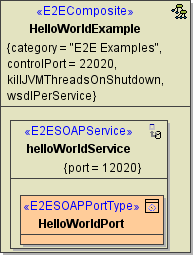Find below an example of an xUML composite containing an simple SOAP service:
Component Diagram of the HelloWorldExample
The <<E2ESOAPService>> holds the following tagged values:
| Name Dialog / Tag / Parameter | Description | Allowed Values | |
|---|---|---|---|
| Authentication | |||
| Authentication Mode (authenticationMode) |
Defines the authentication mode to be used with this SOAP service.
Independent of the authentication mode, the user is found in the principal object if the authentication succeeded. |
none | no authentication |
| HTTPBasicAuth | HTTP basic authentication | ||
| HTTPRemoteAuth | HTTP remote authentication | ||
| User (user) |
Specifies user and password for the use of HTTP Basic authentication. | Example: user/password | |
| HTTP | |||
| Port (port) |
Specifies the machine port number the service is binding to. This port number can be given at the service level only.
|
any positive integer | |
| Max Request Body Size (maxRequestBodySize) |
Runtime 2021.2 Specifies the maximum size of the request in KB (1 KB = 1024 Bytes). This can be used to prevent DoS or similar attacks. When the payload of the service exceeds the given maximum, incoming request are rejected. If you have multiple SOAP services in one composite, you can only apply the same value to all. If you specify different values on each of them, the Runtime will pick one and apply them to all. |
any positive integer | |
| 0 | Accept unlimited requests (default of services compiled with Builder versions < 7.12.0). |
||
| 2048 | Builder 7.12.0 2MB (default if not specified). | ||
| Max Request Header Size (maxRequestHeaderSize) |
Runtime 2022.6 Specifies the maximum size of the request header in KB (1 KB = 1024 Bytes). This can be used to prevent DoS or similar attacks. When the header payload of the service exceeds the given maximum, incoming request are rejected. Compatibility Hint For older Runtimes, a limit of 8 KB applies.
If you have multiple SOAP services in one composite, you can only apply the same value to all. If you specify different values on each of them, the Runtime will pick one and apply them to all. |
any positive integer | |
| 8 |
8 KB (default if not specified). | ||
| Proxy | |||
| External Proxy Host (externalProxyHost) |
Specifies the host name as seen by the client.
|
||
| Proxy Protocol (proxyProtocol) |
Specifies the used proxy protocol.
|
HTTP | use the HTTP protocol |
| HTTPS | use the HTTPS protocol (default) | ||
| Proxy Host (proxyHost) |
Specifies the host for the proxy deployment. If localhost is used, the proxy will be created on the same host the service is deployed to. Use a dedicated host, if you want to run your proxy on a different host of the same Bridge domain. See also externalProxyHost. |
any name | |
| localhost | default | ||
| Proxy Port (proxyPort) |
Specifies the port the proxy is listening to.
|
any number | |
| 80 | default for HTTP | ||
| 443 | default for HTTPS | ||
| Proxy Path (proxyPath) |
Specifies the part of the overall URL that is mapped to the actual host name and port. If proxyPath is used, the modeler must ensure that this value is unique within the proxy. |
<proxy URL>/<service host>/<composite name> | default |
| SOAP | |||
| Encoding (encoding) |
Defines the encoding of the SOAP operation. See Encoding of SOAP Operations for more information on SOAP encoding and the Bridge. |
rpc/soap | SOAP Remote Procedure Call (RPC) encoding |
| doc/literal | SOAP document-style encoding | ||
| Timezone (timezone) |
Time zone string as specified in the time zone appendix. timezone is used to print DateTime expressions.
|
Examples: If "local" is used, the date/time is printed relative to the local timezone of the Bridge, for example: |
|
| Date Format String (dateFormatString) |
Date formatting code as listed in Date and Time Formatting. If nothing is defined, the XSD standard is used.
|
Example: %F
|
|
| Wsdl Namespace (wsdlNamespace) |
Specifies the target namespace of the generated WSDL file. This is relevant only, if wsdlPerService in the xUML composite is true (see Frontend Components).
|
||
